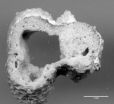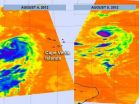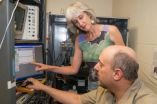(Press-News.org) Microbes, sponges, and worms—the side effects of pollution and heavy fishing—are adding insult to injury in Kenya's imperiled reef systems, according to a recent study by the Wildlife Conservation Society and the University of Azores.
The authors of the study have found that pollution and overfishing on reef systems have an ecological cascading effect—the proliferation of microbes, sponges, and worms—that further degrade corals, a discovery that underlines the complexity of reefs and possible solutions.
The study appears in the online edition of Marine Ecology Progress Series. The authors include M. Carreiro-Silva of the Center of IMAR of the University of Azores and Tim McClanahan of the Wildlife Conservation Society.
The paper examines how human activities can create unexpected complications in coral reef recovery and management. For instance, recent experimental studies by Carreiro-Silva and colleagues in Belize and Kenya demonstrated that a higher nutrient content in coral reefs associated with growing agriculture activity and urbanization increased the rate at which reefs eroded from microbes such as bacteria, fungi, and algae, as well as larger animals like sponges and worms. While the study cites previous work suggesting a faster erosion of reef calcium carbonate with high pollution levels, the experimental manipulations and use of reefs experiencing different levels of fishing and pollution strongly supports those previous conclusions.
An entirely new finding from this research is that worms are major eroders of reefs where fishing is heavy, while sponges play this same role in unfished reefs of the kind found in marine parks. This suggests that it is not only nutrients and pollution that are eroding the reef substratum. Marine consumers like fish and sea-urchins also appear to be influencing species that erode the reef substratum.
In heavily fished reefs, sea-urchins are the dominant grazers, and their grazing activity is so intense that only fast-growing early colonist species such as worms are able to grow inside the reef substratum. The lack of fish may also make these holes a safe haven for worms. In this scenario, worms then take over the role that sponges usually play.
"This change in the roles of worms and sponges shows how the affects of fishing can cascade down even into the hidden crevices of coral reefs," said Dr. Carreiro-Silva of the Department of Oceanography and Fisheries at the University of the Azores in Portugal and the lead author of the study.
In areas impacted with high levels of runoff and drainage from land, such as some of the oldest marine parks in Kenya, researchers have found the highest levels of reef decay; in these instances, the increased pollution produces an abundance of sponges that live in and erode reef cavities.
Dr. Tim McClanahan, senior conservationist for the Wildlife Conservation Society and co-author of the study added: "This problem is outside of the usual control of park managers and shows the importance of maintaining clean waters if reefs are to grow and keep up with the rise in sea levels."
The study authors are concerned about the cascading effects of pollution and overfishing on already stressed coral reef systems. Intensive erosion of carbonates has the potential to undermine reef growth and diminish reef structure over time, an increasing challenge as ocean temperatures and sea levels rise. The authors point out that reducing pollution, the influence of run-off, drainage of highlands and wetlands, and other sources of non-point pollution and land development in coastal areas are critical in conserving the ecological services provided by coral reefs.
Dr. Carreiro-Silva speculates that one unstudied but looming problem is the increased acidification of the ocean that will add to the growing intensity of impacts. Acidification created by increased emissions of carbon dioxide weakens coral skeletons and creates opportunities for species that like to live in hidden crevices and further dissolve the reef structure.
"Ultimately, the synergy between these different impacts may lead to the deterioration and eventual collapse of the reefs unless greater efforts are made to reduce the many sources of pollution and excessive use of coral reefs as fisheries," she added.
INFORMATION:
Microbes, sponges, and worms add to coral reef woes
Study by Wildlife Conservation Society and University of the Azores identifies additional risks to reefs stemming from pollution and heavy fishing
2012-08-07
ELSE PRESS RELEASES FROM THIS DATE:
NASA watches Tropical Storm Florence develop and weaken
2012-08-07
The sixth tropical storm of the Atlantic Ocean hurricane season formed over the past weekend, and NASA kept an on its progression. Tropical Storm Florence was born in the eastern Atlantic and weakened when it interacted with dry air.
On Friday, August 3, the low pressure area known as "System 90L" was being watched for development. It was located south of the Cape Verde Islands off the African coast. By the early evening (Eastern Daylight Time) it quickly organized. System 90L strengthened and became Tropical Storm Florence in the eastern Atlantic. Over August 4 and 5 ...
Researchers unlock secret of the rare 'twinned rainbow'
2012-08-07
ZURICH — Scientists have yet to fully unravel the mysteries of rainbows, but a group of researchers from Disney Research, Zürich, UC San Diego, Universidad de Zaragoza, and Horley, UK, have used simulations of these natural wonders to unlock the secret to a rare optical phenomenon known as the twinned rainbow.
Unlike the more common double-rainbow, which consists of two separate and concentric rainbow arcs, the elusive twinned rainbow appears as two rainbows arcs that split from a single base rainbow. Sometimes it is even observed in combination with a double rainbow. ...
Study: Telling fewer lies linked to better health and relationships
2012-08-07
"Pants on fire" isn't the only problem liars face. New research from the University of Notre Dame shows that when people managed to reduce their lies in given weeks across a 10-week study, they reported significantly improved physical and mental health in those same weeks.
Funded by a grant from the John Templeton Foundation, the "Science of Honesty" study was presented recently at the American Psychological Association's 120th annual convention.
"We found that the participants could purposefully and dramatically reduce their everyday lies, and that in turn was associated ...
NASA sees Typhoon Haikui approaching China in visible and infrared light
2012-08-07
Two NASA satellites have captured data on the activity of Typhoon Haikui as it nears the China coast. NASA's Terra satellite provided a visible look at the storm, while NASA's Aqua satellite investigated it in infrared light. Both showed some strong thunderstorms within that were likely packing heavy rainfall.
NASA's Aqua satellite passed over Typhoon Haikui on August 5. The AIRS instrument captured an infrared image of the cloud temperatures that showed the strongest storms and heaviest rainfall in all quadrants of the storm except the northern area. The strongest storms ...
Disney Research technique improves rendering of smoke, dust and participating media
2012-08-07
ZURICH – Computer graphic artists often struggle to render smoke and dust in a way that makes a scene look realistic, but researchers at Disney Research, Zürich, Karlsruhe Technical Institute in Germany, and the University of Montreal in Canada have developed a new and efficient way to simulate how light is absorbed and scattered in such scenes.
"Our technique could be used to simulate anything from vast cloudscapes, to everyday 'solid' objects such as a glass of orange juice, a piece of fruit or virtually any organic substance," said Dr. Wojciech Jarosz of Disney Research ...
The scientific side of steroid use and abuse
2012-08-07
Leslie Henderson is concerned about steroid abuse, not necessarily by sports luminaries like Barry Bonds and Mark McGwire, but rather by adolescents.
"There is this disconnect among young people that somehow your emotions, your thought processes—things that have to do with your brain—are separate and different from what steroids may be doing to your body—your muscles, your heart, or your liver, or anything like that," says Henderson, a professor of physiology and neurobiology, and of biochemistry at the Geisel School of Medicine at Dartmouth. She is also the senior associate ...
Risk of stroke from cardiac catheterizations
2012-08-07
MAYWOOD, Il. -- When a patient undergoes a cardiac catheterization procedure such as a balloon angioplasty, there's a slight risk of a stroke or other neurological complication.
While the risk is extremely small, neurologists nevertheless may expect to see catheterization-induced complications because so many procedures are performed, Loyola neurologists write in the journal MedLink Neurology.
Cardiac catheterizations include diagnostic angiograms, balloon angioplasties and stent placements. More than 1.4 million procedures are successfully performed each year. Cardiac ...
Mothers, children underestimate obesity in China
2012-08-07
Childhood obesity is on the rise in China, and children and parents there tend to underestimate body weight, according to Penn State health policy researchers.
"Because many overweight Chinese children underestimate their weight, they are less likely to do anything to improve their diet or exercise patterns," said Nengliang Yao, graduate student in health policy and administration. "If they don't make changes, they are likely to be obese and have a lot of health problems in the future -- as we often see in the United States already."
Children between the ages of 6 and ...
New study examines injuries to US workers with disabilities
2012-08-07
A new study conducted by researchers at the Center for Injury Research and Policy of The Research Institute at Nationwide Children's Hospital and The Ohio State University compared medically attended noncccupational and occupational injuries among U.S. workers with and without disabilities.
The study, appearing online in the American Journal of Public Health, found that workers with disabilities are significantly more likely to experience both nonoccupational and occupational injuries than those without disabilities. Rates of nonoccupational and occupational injuries ...
Racial differences in diabetes diagnostic thresholds
2012-08-07
BOSTON – Healthcare providers should take into account differences among racial groups when using hemoglobin A1C levels to diagnose and monitor diabetes, new research from Beth Israel Deaconess Medical Center suggests.
In a study published Aug. 7 in the Annals of Internal Medicine, researchers analyzed National Health and Nutrition Survey data from 2005 to 2008 to examine the association between hemoglobin A1C levels in black and white adults and the risk for retinopathy, an eye complication of diabetes that is detectable early in the disease and can ultimately lead to ...
LAST 30 PRESS RELEASES:
The impact of family dynamics on eating behaviour – how going home for Christmas can change how you eat
Tracing the quick synthesis of an industrially important catalyst
New software sheds light on cancer’s hidden genetic networks
UT Health San Antonio awarded $3 million in CPRIT grants to bolster cancer research and prevention efforts in South Texas
Third symposium spotlights global challenge of new contaminants in China’s fight against pollution
From straw to soil harmony: International team reveals how biochar supercharges carbon-smart farming
Myeloma: How AI is redrawing the map of cancer care
Manhattan E. Charurat, Ph.D., MHS invested as the Homer and Martha Gudelsky Distinguished Professor in Medicine at the University of Maryland School of Medicine
Insilico Medicine’s Pharma.AI Q4 Winter Launch Recap: Revolutionizing drug discovery with cutting-edge AI innovations, accelerating the path to pharmaceutical superintelligence
Nanoplastics have diet-dependent impacts on digestive system health
Brain neuron death occurs throughout life and increases with age, a natural human protein drug may halt neuron death in Alzheimer’s disease
SPIE and CLP announce the recipients of the 2025 Advanced Photonics Young Innovator Award
Lessons from the Caldor Fire’s Christmas Valley ‘Miracle’
Ant societies rose by trading individual protection for collective power
Research reveals how ancient viral DNA shapes early embryonic development
A molecular gatekeeper that controls protein synthesis
New ‘cloaking device’ concept to shield sensitive tech from magnetic fields
Researchers show impact of mountain building and climate change on alpine biodiversity
Study models the transition from Neanderthals to modern humans in Europe
University of Phoenix College of Doctoral Studies releases white paper on AI-driven skilling to reduce burnout and restore worker autonomy
AIs fail at the game of visual “telephone”
The levers for a sustainable food system
Potential changes in US homelessness by ending federal support for housing first programs
Vulnerability of large language models to prompt injection when providing medical advice
Researchers develop new system for high-energy-density, long-life, multi-electron transfer bromine-based flow batteries
Ending federal support for housing first programs could increase U.S. homelessness by 5% in one year, new JAMA study finds
New research uncovers molecular ‘safety switch’ shielding cancers from immune attack
Bacteria resisting viral infection can still sink carbon to ocean floor
Younger biological age may increase depression risk in older women during COVID-19
Bharat Innovates 2026 National Basecamp Showcases India’s Most Promising Deep-Tech Ventures
[Press-News.org] Microbes, sponges, and worms add to coral reef woesStudy by Wildlife Conservation Society and University of the Azores identifies additional risks to reefs stemming from pollution and heavy fishing



